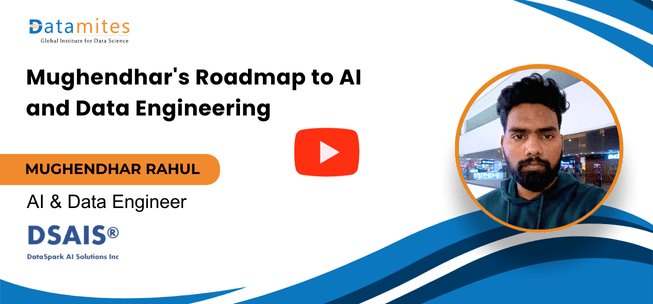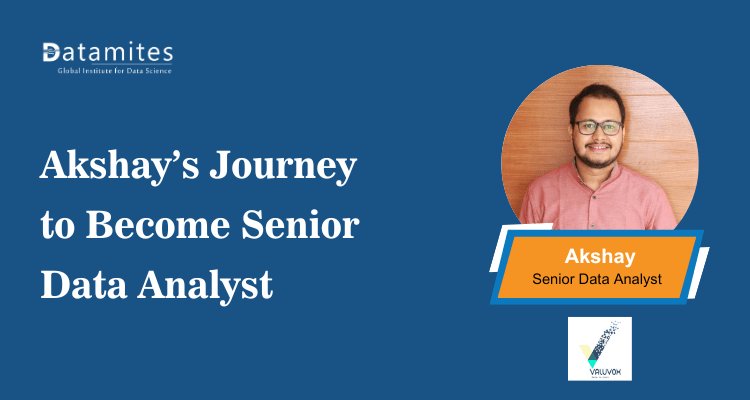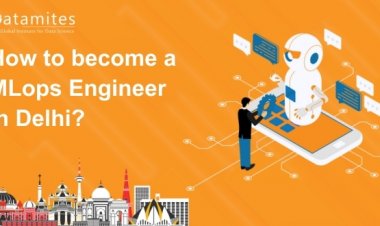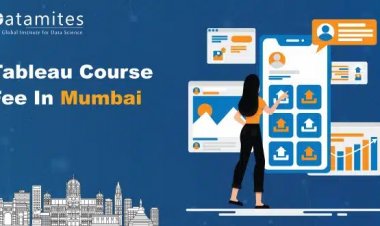Mughendhar’s Journey from Mechanical Engineering to AI Professional
Discover Mughendhar’s inspiring journey from a mechanical engineering background to becoming a successful AI professional. Learn how he transitioned careers, upskilled in AI, and built a future in the world of artificial intelligence.
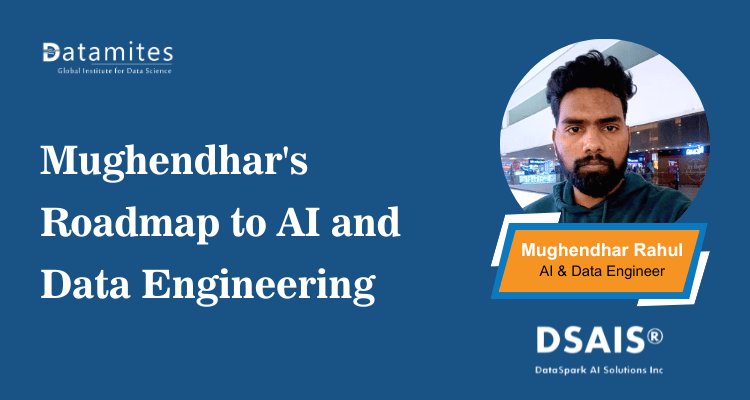
From solving thermodynamics problems to building intelligent AI models, Rahul’s journey is a testament to how determination, structured learning, and hands-on experience can transform a career. Starting as a mechanical engineering graduate with little exposure to coding or data science, Rahul navigated the complex world of machine learning, NLP, and computer vision to become a successful AI professional. If you’ve ever wondered how someone from a non-technical background can break into data science and AI, Rahul’s story offers inspiration, practical insights, and a roadmap to make it possible.
Exclusive Q&A with Rahul: From Mechanical Engineer to AI Engineer Success Story
Discover how Rahul transformed his career from mechanical engineering to becoming a successful AI Engineer. In this exclusive Q&A, he shares his journey, challenges, and tips for aspiring data science professionals.
Q1: Rahul, could you please introduce yourself and your background?
Hi, my name is Mugender Rahul. I completed my BE in Mechanical Engineering in 2023. After graduation, I worked as a Petroleum Inspector at Qatar Energy. However, due to health reasons, I decided to change my career path and move into data science.
I joined DataMites, completed my internship at Rubixe, and later got placed at Data Spark AI as an AI Engineer.
Q2: Coming from a non-programming background, what motivated you to choose data science?
Since petroleum jobs demanded a lot physically and had health risks, I wanted to shift toward a field that is both intellectually challenging and future-proof. Data science fascinated me because it combines problem-solving with innovation.
Q3: How was your learning experience when you first joined DataMites?
The syllabus started with Python, followed by SQL, Machine Learning, and Deep Learning. Initially, Machine Learning (ML) was quite difficult for me. But thanks to my mentors, who focused on the basics and practical implementation, I gradually gained confidence.
Python took me about a month to get comfortable with. Once I understood ML fundamentals, the rest of the topics became easier.
Q4: What projects did you work on during your course and internship?
I worked on 4 capstone projects, including classification and regression problems.
During my internship, I contributed to client projects in Natural Language Processing (NLP) and Computer Vision (CV). Some projects I completed individually, while others were in a team of three.
These hands-on projects gave me practical exposure and built my confidence for real-world challenges.
Q5: Did you use additional resources apart from DataMites materials?
Yes. While I mostly relied on the LMS portal and course syllabus, I occasionally referred to YouTube tutorials for extra clarity.
I also used ChatGPT extensively. I would ask it to create 10–20 questions on any topic I studied, then answer those questions to assess my understanding. It felt like a self-evaluation tool and even helped me practice mock interviews.
Q6: Rahul, what tips would you give students preparing for data science interviews?
Students should not limit themselves to only Machine Learning (ML) and Deep Learning (DL) projects. Instead, they must explore diverse areas like Computer Vision (CV), Natural Language Processing (NLP), and even emerging technologies like LLMs (Large Language Models).
Q7: How important are new technologies like LLMs and Generative AI for data science careers?
Extremely important. Today, even simple tasks like sentiment analysis are powered by LLMs. Most companies now integrate some aspect of Generative AI into their projects.
Q8: Can you share your overall experience with DataMites training, projects, and placements?
I would say everything was perfect. The syllabus covered not just Python, ML, and DL but also Azure and AWS cloud technologies, which added great value.
The projects were real-time industry projects, which I could confidently showcase on my resume. Earlier, despite applying to over 500 companies, I didn’t receive a single interview call. But once I connected with the placement assistance (PA) team at DataMites, everything changed. They arranged interviews, helped me prepare, and I cracked multiple offers.
Q9: You mentioned earlier about applying to 500+ companies without success. Why do you think resumes often don’t get responses?
The biggest challenge is the volume of applications. A single job posting on LinkedIn can receive up to 10,000 applications. Many resumes get filtered out by ATS (Applicant Tracking Systems) before even reaching recruiters.
The advantage of DataMites’ placement team is that they have a strong network of 1000+ employers. They pre-assess candidates with mock interviews and job readiness tests before sending them to companies. This saves employers time and builds trust so they prefer hiring repeatedly from this pool.
Q10: Rahul, which platform did you use for resume building?
I didn’t use any online platform. The Placement Assistance Team at DataMites personally helped me refine my resume. They guided me on highlighting projects effectively and tailoring it for data science roles.
Q11: Rahul, what type of questions can one expect in data science interviews?
In most interviews, the focus starts with Machine Learning (ML) algorithms. Recruiters typically ask you to:
- Explain all ML algorithms you’ve learned.
- Highlight your favorite algorithm and why.
- Answer tricky questions about evaluation metrics like accuracy, precision, and recall for example, why use precision instead of accuracy.
Q12: As a fresher, what if the company expects you to learn new technologies after joining?
It’s normal. Companies often ask employees to upskill and adapt. The key is to be open to learning and stay curious. You will gradually get deeper into project requirements and industry tools.
Q13: What projects are you currently working on in your company?
I’m currently working on NLP and computer vision projects. While I can’t disclose company-specific details, I can say that hands-on work in these areas strengthens both understanding and practical application.
Q14: How long did it take for you to get placed after completing your course?
For me, it took about 2 months. During this period, I completed all my projects and prepared for interviews. On average, placement can take 3–4 months, but dedicated effort can accelerate the process.
Q15: Can someone from mechanical engineering or non-CS backgrounds take a data science course?
Absolutely. Many mechanical engineering students excel in data science because ML and DL algorithms often rely on mathematical concepts such as integration and calculus areas mechanical engineers are familiar with.
Q16: Any final advice for aspiring data scientists?
- Work hard and stay consistent.
- Engage in real projects to gain practical exposure.
- Stay updated with new algorithms, tools, and industry trends.
- Leverage support from mentors, placement assistance teams, and communities to accelerate learning and career growth.
Refer these below articles:
- From Fresher to AI Engineer – Darshan’s Success Story
- Junaid’s Path to MLOps Excellence: Data Meets Deployment
- Marketing Analyst to Generative AI Engineer: Keerthan’s Inspiring Journey
Key Findings from Rahul’s journey and insights
Career Shift Motivation: Rahul transitioned from Mechanical Engineering and a physically demanding petroleum job to data science due to health concerns and the desire for a future-proof, intellectually challenging career.
Learning Journey:
- Started with Python, SQL, ML, and DL at DataMites.
- Initially struggled with ML but gained confidence through mentor guidance and practical implementation.
- Python mastery took about a month.
Hands-On Projects:
- Completed 4 capstone projects including classification, regression, NLP, and Computer Vision.
- Internship experience at Rubixe provided exposure to real-world AI projects.
- Projects helped build practical skills and resume credibility.
Use of Additional Resources:
- Used YouTube tutorials for extra clarity.
- Leveraged ChatGPT for creating self-evaluation questions and mock interview practice.
Interview Preparation Tips:
- Don’t limit yourself to ML and DL; explore NLP, CV, and emerging tech like LLMs and Generative AI.
- Understanding diverse technologies increases employability.
Read these below articles:
- How to Choose the Best Institute for AI/ML in Mumbai?
- How Artificial Intelligence is Transforming Digital Marketing
- How to Choose Best Institute for AI/ML in Chennai?
Rahul’s journey is proof that with determination, mentorship, and consistent effort, anyone can transition into a rewarding career in artificial intelligence. From mechanical engineering to AI engineering, his transformation showcases the opportunities this field holds for professionals from diverse backgrounds.
Hyderabad has emerged as a major technology hub in India, known for its innovation-driven environment, strong IT services, and dynamic startup culture. With the rapid adoption of artificial intelligence across industries such as healthcare, finance, retail, and telecommunications, the demand for skilled AI professionals in the city is on the rise. An Artificial Intelligence institute in Hyderabad equips learners with practical knowledge, advanced tools, and industry-focused expertise to thrive in this ever-evolving domain.
DataMites is recognized as one of the leading artificial intelligence institutes in coimbatore, offering extensive programs in AI, Machine Learning, and Data Science. The training is designed to be highly practical, combining real-world projects with globally respected certifications from bodies like IABAC and NASSCOM FutureSkills. Along with technical expertise, the institute also provides career-oriented support, including resume development, interview coaching, and placement guidance to help learners succeed in the AI industry.
